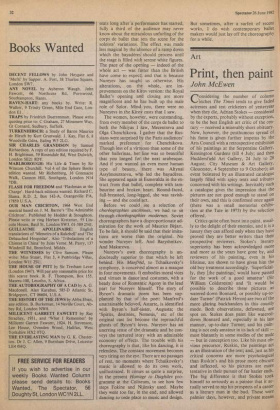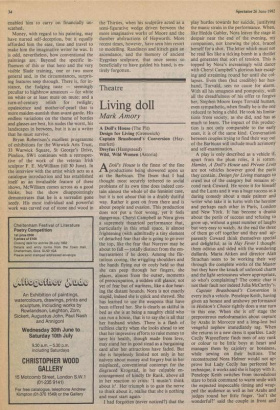Art
Print, then paint
John McEwen
onsidering the number of column
inches The Times tends to give faded actresses and test cricketers of yesteryear when they die, Adrian Stokes — considered by the experts, probably without exception, to be the best English art critic of the cen- tury — received a miserably short obituary. Now, however, the posthumous spread of his fame is given further impetus by the Arts Council with a retrospective exhibition of his paintings at the Serpentine Gallery, Kensington Gardens (till 4 July; and then Huddersfield Art Gallery, 24 July to 28 August; City Museum & Art Gallery, Gloucester, 4 September to 9 October); an event bolstered by an illustrated catalogue largely filled with spicy texts and tributes concerned with his writings. Inevitably such a catalogue gives the impression that the pictures are not good enough to stand on their own, and this is confirmed once again (there was a small memorial exhibi- tion at the Tate in 1973) by the selection offered.
Critics quite often burst into paint, usual- ly to the delight of their enemies, and it is a luxury they can afford only when they have proved they are better writers than their prospective reviewers. Stokes's literary superiority has been acknowledged more and more as the years have gone by, and reviewers of his painting, even in his lifetime, are shown to have given him the old boy treatment accordingly. 'Superficial- ly, they [the paintings] would have passed for the work of a good amateur' (Sir William Coldstream) and 'It would be possible to describe these pictures as watered-down Bonnard, or possibly up-to- date Turner' (Patrick Heron) are two of the more glaring backhanders in this courtlY mode. Both observations, defawned, are spot on. Stokes does paint like watered- down Bonnard and, especially in his late manner, up-to-date Turner; and his pain- ting is not only amateur in its lack of skill — most blatantly in some studies of the nude — but in conception too. Like his most ob- vious precursor, Ruskin, the paintings act as an illustration of the text; and, just as his critical concerns are more psychological than Ruskin's and his prose more obscure and inflected, so his pictures are more tentative in their pursuit of far hazier ends. The big difference is that Stokes took himself so seriously as a painter that it ac- tually served to nip his prospects of a career as a literary man in the bud. Those were palmier days, however, and private means
enabled him to carry on financially un- scathed.
Money, with regard to his painting, may have nursed self-deception, but it equally afforded him the ease, time and travel to make him the imaginative writer he was. It is odd, nevertheless, how conventional the paintings are. Beyond the specific in- fluences of this or that hero and the very visible Slade training, one or two more general and, in the circumstances, surpris- ing features seep through. There is, for in stance, the fudging taste — seemingly peculiar to highbrow amateurs — for white on white or at least mute on mute; and a turn-of-century relish for twilight, opalescence and mother-of-pearl that is more maiden-auntish than avant-garde. His endless variations on the theme of bottles and glasses are best, his nudes the worst, his landscapes in between, but it is as a writer that he must survive.
Bryan Robertson's excellent programme of exhibitions for the Warwick Arts Trust, 33 Warwick Square, St George's Drive, Pimlico, SW I continues with a retrospec- tive of the work of the veteran Irish sculptor F. E. McWilliam (till 30 June). In the interview with the artist which acts as a catalogue introduction and has established itself as an invaluable feature of these shows, McWilliam comes across as a good bloke; but the show disappointingly demonstrates that he is a surrealist gone seedy. His most individual and powerful work was carved out of stone and wood in the Thirties, when his sculpture acted as a semi-figurative wedge driven between the more imaginative works of Moore and the dumber abAractions of Hepworth. More recent times, however, have seen him resort to modelling. Randincss and kitsch gain an ascendance, and the memory of ancient Eygptian sculpture, that once seems so beneficially to have guided his hand, is en- tirely forgotten.























































 Previous page
Previous page